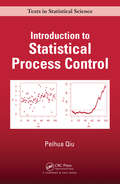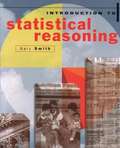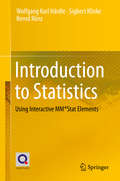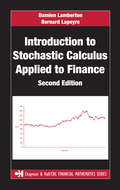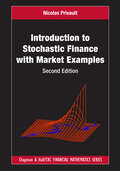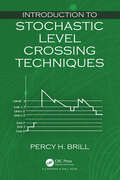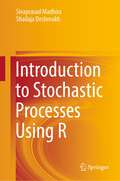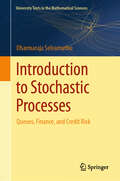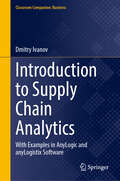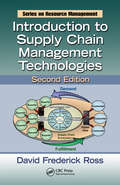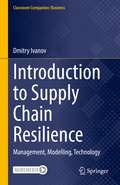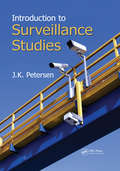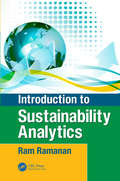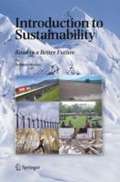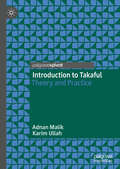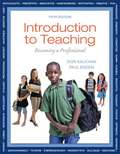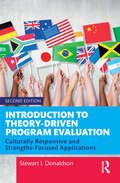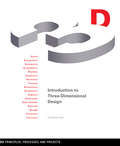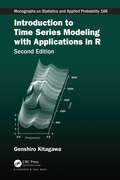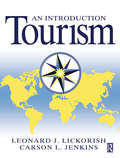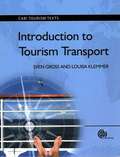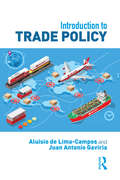- Table View
- List View
Introduction to Statistical Process Control (Chapman & Hall/CRC Texts in Statistical Science)
by Peihua QiuA major tool for quality control and management, statistical process control (SPC) monitors sequential processes, such as production lines and Internet traffic, to ensure that they work stably and satisfactorily. Along with covering traditional methods, Introduction to Statistical Process Control describes many recent SPC methods that improve upon
Introduction to Statistical Reasoning
by Gary N. SmithThis textbook is intended for an introductory statistics course that will help students to develop their statistical reasoning. This book provides hundreds of interesting and relevant examples, and discusses not only the uses but also the abuses of statistics. These examples show how statistical reasoning can be used correctly to answer important questions and it also exposes the errors--accidental or intentional--that people often make with statistics. The book has special features of: Have You Ever Wondered?, How To Do It Boxes, Student Projects, Real Data, and Technology.
Introduction to Statistics: Using Interactive MM*Stat Elements
by Wolfgang Karl Härdle Sigbert Klinke Bernd RönzThis book covers all the topics found in introductory descriptive statistics courses, including simple linear regression and time series analysis, the fundamentals of inferential statistics (probability theory, random sampling and estimation theory), and inferential statistics itself (confidence intervals, testing).Each chapter starts with the necessary theoretical background, which is followed by a variety of examples. The core examples are based on the content of the respective chapter, while the advanced examples, designed to deepen students’ knowledge, also draw on information and material from previous chapters.The enhanced online version helps students grasp the complexity and the practical relevance of statistical analysis through interactive examples and is suitable for undergraduate and graduate students taking their first statistics courses, as well as for undergraduate students in non-mathematical fields, e.g. economics, the social sciences etc.
Introduction to Stochastic Calculus Applied to Finance (Chapman and Hall/CRC Financial Mathematics Series)
by Damien Lamberton Bernard LapeyreSince the publication of the first edition of this book, the area of mathematical finance has grown rapidly, with financial analysts using more sophisticated mathematical concepts, such as stochastic integration, to describe the behavior of markets and to derive computing methods. Maintaining the lucid style of its popular predecessor, this concise and accessible introduction covers the probabilistic techniques required to understand the most widely used financial models. Along with additional exercises, this edition presents fully updated material on stochastic volatility models and option pricing as well as a new chapter on credit risk modeling. It contains many numerical experiments and real-world examples taken from the authors' own experiences. The book also provides all of the necessary stochastic calculus theory and implements some of the algorithms using SciLab. Key topics covered include martingales, arbitrage, option pricing, and the Black-Scholes model.
Introduction to Stochastic Finance with Market Examples (Chapman and Hall/CRC Financial Mathematics Series)
by Nicolas PrivaultIntroduction to Stochastic Finance with Market Examples, Second Edition presents an introduction to pricing and hedging in discrete and continuous-time financial models, emphasizing both analytical and probabilistic methods. It demonstrates both the power and limitations of mathematical models in finance, covering the basics of stochastic calculus for finance, and details the techniques required to model the time evolution of risky assets. The book discusses a wide range of classical topics including Black–Scholes pricing, American options, derivatives, term structure modeling, and change of numéraire. It also builds up to special topics, such as exotic options, stochastic volatility, and jump processes. New to this Edition New chapters on Barrier Options, Lookback Options, Asian Options, Optimal Stopping Theorem, and Stochastic Volatility Contains over 235 exercises and 16 problems with complete solutions available online from the instructor resources Added over 150 graphs and figures, for more than 250 in total, to optimize presentation 57 R coding examples now integrated into the book for implementation of the methods Substantially class-tested, so ideal for course use or self-study With abundant exercises, problems with complete solutions, graphs and figures, and R coding examples, the book is primarily aimed at advanced undergraduate and graduate students in applied mathematics, financial engineering, and economics. It could be used as a course text or for self-study and would also be a comprehensive and accessible reference for researchers and practitioners in the field.
Introduction to Stochastic Level Crossing Techniques
by Percy H. BrillIntroduction to Stochastic Level Crossing Techniques describes stochastic models and their analysis using the System Point Level Crossing method (abbreviated SPLC or LC). This involves deriving probability density functions (pdfs) or cumulative probability distribution functions (cdfs) of key random variables, applying simple level-crossing limit theorems developed by the author. The pdfs and/or cdfs are used to specify operational characteristics about the stochastic model of interest. The chapters describe distinct stochastic models and associated key random variables in the models. For each model, a figure of a typical sample path (realization, i.e., tracing over time) of the key random variable is displayed. For each model, an analytic (Volterra) integral equation for the stationary pdf of the key random variable is created−by inspection of the sample path, using the simple LC limit theorems. This LC method bypasses a great deal of algebra, usually required by other methods of analysis. The integral equations will be solved directly, or computationally. This book is meant for students of mathematics, management science, engineering, natural sciences, and researchers who use applied probability. It will also be useful to technical workers in a range of professions. Key Features: A description of one representative stochastic model (e.g., a single-server M/G/1 queue; a multiple server M/M/c queue; an inventory system; etc.) Construction of a typical sample path of the key random variable of interest (e.g., the virtual waiting time or workload in queues; the net on-hand inventory in inventory systems; etc.) Statements of the simple LC theorems, which connect the sample-path upcrossing and downcrossing rates across state-space levels, to simple mathematical functions of the stationary pdf of the key random variable, at those state-space levels Creation of (usually Volterra) integral equations for the stationary pdf of the key random variable, by inspection of the sample path Direct analytic solution of the integral equations, where feasible; or, computational solutions of the integral equations Use of the derived stationary pdfs for obtaining operational characteristics of the model
Introduction to Stochastic Processes Using R
by Shailaja Deshmukh Sivaprasad MadhiraThis textbook presents some basic stochastic processes, mainly Markov processes. It begins with a brief introduction to the framework of stochastic processes followed by the thorough discussion on Markov chains, which is the simplest and the most important class of stochastic processes. The book then elaborates the theory of Markov chains in detail including classification of states, the first passage distribution, the concept of periodicity and the limiting behaviour of a Markov chain in terms of associated stationary and long run distributions. The book first illustrates the theory for some typical Markov chains, such as random walk, gambler's ruin problem, Ehrenfest model and Bienayme-Galton-Watson branching process; and then extends the discussion when time parameter is continuous. It presents some important examples of a continuous time Markov chain, which include Poisson process, birth process, death process, birth and death processes and their variations. These processes play a fundamental role in the theory and applications in queuing and inventory models, population growth, epidemiology and engineering systems. The book studies in detail the Poisson process, which is the most frequently applied stochastic process in a variety of fields, with its extension to a renewal process. The book also presents important basic concepts on Brownian motion process, a stochastic process of historic importance. It covers its few extensions and variations, such as Brownian bridge, geometric Brownian motion process, which have applications in finance, stock markets, inventory etc. The book is designed primarily to serve as a textbook for a one semester introductory course in stochastic processes, in a post-graduate program, such as Statistics, Mathematics, Data Science and Finance. It can also be used for relevant courses in other disciplines. Additionally, it provides sufficient background material for studying inference in stochastic processes. The book thus fulfils the need of a concise but clear and student-friendly introduction to various types of stochastic processes.
Introduction to Stochastic Processes: Queues, Finance, and Credit Risk (University Texts in the Mathematical Sciences)
by Dharmaraja SelvamuthuThis is an essential textbook for senior undergraduate and graduate students of statistics, stochastic processes, stochastic finance, and probability theory. It covers all the important notations of probability theory and stochastic processes that are crucial for students to overcome their initial challenges during their studies. It thoroughly discusses the concepts of stochastic processes, both Markov and non-Markov processes, as well as stochastic calculus. With a special focus on finance, the book dedicates three chapters to explore the applications of stochastic processes in options, credit risk and insurance. Organized into sixteen chapters and one appendix, the book takes the readers to a well-organized learning. To fully grasp the intricacies of stochastic processes, students are expected to have a solid grounding in real analysis, linear algebra, and differential equations. Practical examples are emphasized throughout the book, carefully selected from various fields. The exercises at the end of each chapter are designed with the same objective in mind. Stochastic processes play a significant role in various scientific disciplines and real-life applications.
Introduction to Stockholders' Equity
by Jacob Cohen Thomas D. FieldsThe stockholders' equity section of the balance sheet illustrates details of accounting for stock offerings, common stock, and preferred stock. Accounting for dividends, both cash and stock dividends, and treasury stock is covered.
Introduction to Strategic Innovation
by Chris Trimble Vijay GovindarajanIn today's marketplace, characterized by rapid and nonlinear change, executing strategic innovation successfully has become imperative for generating sustained growth and extending the corporate life span. In this chapter, the authors describe and demystify strategic innovation.
Introduction to Supply Chain Analytics: With Examples in AnyLogic and anyLogistix Software (Classroom Companion: Business)
by Dmitry IvanovThe book offers a concise yet comprehensive introduction to supply chain analytics covering management, modeling, and technology perspectives. Designed to accompany the textbook “Global Supply Chain and Operations Management”, it addresses the topics of supply chain analytics in more depth. The book describes descriptive, predictive, and prescriptive supply chain analytics explaining methodologies, illustrating method applications with the use of training exercises, and providing numerous examples in AnyLogic and anyLogistix software. Throughout the book, numerous practical examples and short case studies are given to illustrate theoretical concepts. Along with AnyLogic and anyLogistix model development guidelines and examples, the book has two other distinct features. First, it reviews and explains novel frameworks and concepts related to data-driven decision-making and digital twins. Second, it shows how to use analytics to improve supply chain resilience.Without relying heavily on mathematical derivations, the book offers a structured presentation and explanation of major supply chain analytics techniques and principles in a simple, predictable format to make it easy to understand for students and professionals with both management and engineering backgrounds. Graduate/Ph.D. students and supply chain professionals alike would benefit from a structured and didactically-oriented concise presentation of the concepts, principles, and methods of supply chain analytics. Providing graduate students and supply chain managers with working knowledge of basic and advanced supply chain analytics, this book contributes to improving knowledge-awareness of decision-making in increasingly data-driven and digital environments. The book is supplemented by a companion website offering interactive exercises with the use of AnyLogic and anyLogistix software as well as Spreadsheet Modeling.
Introduction to Supply Chain Management Technologies (Resource Management)
by David Frederick Ross Frederick S. Weston Stephen W.It is almost impossible to conceive of the concept and practical application of supply chain management (SCM) without linking it to the enabling power of today‘s information technologies. Building upon the foundations of the first edition, Introduction to Supply Chain Management Technologies, Second Edition details the software toolsets and suites
Introduction to Supply Chain Resilience: Management, Modelling, Technology (Classroom Companion: Business)
by Dmitry IvanovThis book offers a concise yet comprehensive introduction to supply chain resilience, covering management, modeling and technology perspectives. Designed to accompany the textbook “Global Supply Chain and Operations Management” it addresses the topics of supply chain risks and resilience in more depth, describing the major features of supply chain resilience and explaining methodologies to mitigate supply chain disruptions and recover. Numerous practical examples and short case studies are provided to illustrate theoretical concepts. Without relying heavily on mathematical derivations, the book explains major concepts and methods to build and improve supply chain resilience and tackle supply chain disruption risks in a simple, uniform format to make it easy to understand for students and professionals with both management and engineering backgrounds. Graduate/PhD students and supply chain professionals alike will benefit from the structured, didactically oriented and concise presentation of the concepts, principles and methods of supply chain resilience management, modeling, and technological implementation.
Introduction to Surveillance Studies
by J.K. PetersenSurveillance is a divisive issue one might say it is inherently controversial. Used by private industry, law enforcement, and for national security, it can be a potent tool for protecting resources and assets. It can also be extremely invasive, calling into question our basic rights to freedom and privacy. Introduction to Surveillance Studies explo
Introduction to Sustainability Analytics
by Raghavan Ram RamananThe roles of corporate and public stewards and the nature of their social contract with society have been changing over the past two centuries, and those changes have accelerated in recent decades. Moreover, with increasing focus on sustainability factors from the marketplace (regulators, investors, financiers, and consumers), corporate sustainability disclosure is shifting from voluntary to vital. Corporate and public stewards are now responsible for their performance and services from cradle-to-grave: they must properly manage corporate social responsibility and integrate it into their global strategies, rather than consider it as merely a moral obligation or a risk/reputation management exercise. <P><P> Sustainability analytics, the critical link between sustainability and business strategy, helps professionals track, trend, and transform sustainability information into actionable insights across the value chain and life cycle, to enhance their sustainability performance and its disclosure. This book, Introduction to Sustainability Analytics, provides corporate and public stewards with a comprehensive understanding of how to determine which sustainability metrics are material to them and relevant to their business, and how to incorporate them into corporate strategy, resource allocation, and prioritization. Focusing on practical decision-making needs, it explains how to value and prioritize initiatives, and how to best allocate necessary resources through several real case studies and practical examples. <P><P> Features: <P><P> Examines pressing issues such as climate change, water scarcity, and environmental justice <P><P> Explains how to develop a business case and global strategy for social responsibility <P><P> Includes both corporate and public policy perspectives on sustainability economics <P><P> Covers emerging regulations on sustainability disclosure and responsible investing
Introduction to Sustainability: Road to a Better Future
by Nolberto MunierThis book develops a supporting structure for sustainable development, following a natural set of steps to reach an established goal. It provides the tools to navigate this Road to a Better Future by explaining concepts, giving ideas, proposing methods, and suggesting actions. To illustrate the utilization of techniques there are many examples, applied to a variety of activities, and to wrap up concepts, the last chapter is dedicated to the analysis of a community in search of a sustainable environment. A thematic index has been designed to help a person quickly find information on relevant topics.
Introduction to Takaful: Theory and Practice
by Karim Ullah Adnan MalikThis book provides a comprehensive account of the theory and practice of takaful, which is an Islamic alternative to insurance. The concepts are explained using real-life case studies, calculations, and exhibits to aid in reader learning and reflection. Takaful, both as an academic subject and as well as practice, is growing particularly in the world leading financial and learning hubs such as in the UK and the USA and countries with large Muslim populations in Asia, Africa, and Middle East.
Introduction to Teaching: Becoming a Professional (Fifth Edition)
by Don Kauchak Paul EggenThe best-selling case-based text, Introduction to Teaching: Becoming a Professional, sharpens its focus on issues in education in its Fifth Edition. Weaving this focus throughout every chapter with new features and chapter sections covering diversity, reform, urban education, and technology, the text ensures that prospective teachers gather all the needed information to create an up-to-date picture of the ever changing face of education. The authors take this information and bring it to life with cases, classroom examples and videos, again ensuring that the living, changing, challenging and fulfilling life of an educator is as clear as it can be.
Introduction to Theory-Driven Program Evaluation: Culturally Responsive and Strengths-Focused Applications
by Stewart I. DonaldsonIntroduction to Theory-Driven Program Evaluation provides a clear guide for practicing evaluation science, and numerous examples of how these evaluations actually unfold in contemporary practice. A special emphasis is placed how to conduct theory-driven program evaluations that are culturally responsive and strengths-focused. In this thoroughly revised new edition, author Stewart I. Donaldson provides a state-of-the art treatment of the basics of conducting theory-driven program evaluations. Each case follows a three-step model: developing program impact theory; formulating and prioritizing evaluation questions; and answering evaluation questions. The initial chapters discuss the evolution and popularity of theory-driven program evaluation, as well as step-by-step guide for culturally responsive and strengths-focused applications. Succeeding chapters provide actual cases and discuss the practical implications of theory-driven evaluation science. Reflections, challenges, and lessons learned across numerous cases from practices are discussed. The volume is of significant value to practicing evaluators, professors of introductory evaluation courses and their students, advanced undergraduate and graduate students, and serves as a text or a supplementary text for a wide range of evaluation and applied research courses. It is also of great interest to those interested in the connections between work and health, well-being, career development, human service organizations, and organizational improvement and effectiveness.
Introduction to Three-Dimensional Design: Principles, Processes, and Projects (Design Brief Ser.)
by Kimberly ElamIntroduction to Three-Dimensional Design is the first book to teach graphic design students the fundamentals of three-dimensional design through hands-on drawing and model projects. The book combines key concepts with carefully crafted exercises so students can apply three-dimensional design principles in practice. From initial sketches through experimental prototypes to the final model solutions, students will develop a deeper understanding of the often complex elements and principles of three-dimensional design.
Introduction to Time Series Modeling with Applications in R (Chapman & Hall/CRC Monographs on Statistics and Applied Probability)
by Genshiro KitagawaPraise for the first edition: [This book] reflects the extensive experience and significant contributions of the author to non-linear and non-Gaussian modeling. … [It] is a valuable book, especially with its broad and accessible introduction of models in the state-space framework. –Statistics in Medicine What distinguishes this book from comparable introductory texts is the use of state-space modeling. Along with this come a number of valuable tools for recursive filtering and smoothing, including the Kalman filter, as well as non-Gaussian and sequential Monte Carlo filters. –MAA Reviews Introduction to Time Series Modeling with Applications in R, Second Edition covers numerous stationary and nonstationary time series models and tools for estimating and utilizing them. The goal of this book is to enable readers to build their own models to understand, predict and master time series. The second edition makes it possible for readers to reproduce examples in this book by using the freely available R package TSSS to perform computations for their own real-world time series problems. This book employs the state-space model as a generic tool for time series modeling and presents the Kalman filter, the non-Gaussian filter and the particle filter as convenient tools for recursive estimation for state-space models. Further, it also takes a unified approach based on the entropy maximization principle and employs various methods of parameter estimation and model selection, including the least squares method, the maximum likelihood method, recursive estimation for state-space models and model selection by AIC. Along with the standard stationary time series models, such as the AR and ARMA models, the book also introduces nonstationary time series models such as the locally stationary AR model, the trend model, the seasonal adjustment model, the time-varying coefficient AR model and nonlinear non-Gaussian state-space models. About the Author: Genshiro Kitagawa is a project professor at the University of Tokyo, the former Director-General of the Institute of Statistical Mathematics, and the former President of the Research Organization of Information and Systems.
Introduction to Tourism
by Leonard J Lickorish Carson L JenkinsAn Introduction to Tourism is the essential guide to the tourism industry. It provides a comprehensive and authoritative introduction to all facets of tourism including:the history of tourism; factors influencing the tourism industry; tourism in developing countries; sustainable tourism; forecasting future trends. Tourism has changed radically in recent years with the onset of many technological and economic changes and an ever increasing concern for the environment. This book provides a down-to-earth introduction to this complex and multi-faceted industry.This invaluable introduction is written for all students of tourism and all those involved in the industry who want to know more about the structure, component activities and environment within which they work.
Introduction to Tourism
by Shailja SharmaUsing situational case studies, vignettes on world-class destinations and wide-ranging examples,this book aims to create awareness and understanding on the functioning of the tourism industry. A stepping stone for everyone aspiring to make a career in the tourism and hospitality industry, this textbook builds a strong groundwork of basic concepts and explains theories and their applications in real-life situations. Using situational case studies, vignettes on world-class destinations and wide-ranging examples, Introduction to Tourism aims to create awareness and understanding among the readers on the functioning of the tourism industry. It offers insights into how countries devise their tourism marketing strategies and how to deal with situations while working with tourists and travellers. Each section of the book has been thematically designed and mapped with the curriculum of major universities for distinct learning outcomes. This book is meant to be a compact and constant companion for all students undergoing any kind of training in the tourism and hospitality industry to enhance their professional skills. Key Features: • Special focus on emerging trends and situations in the tourism sector, including the effect of COVID-19 on the industry and its functioning • Comprehensive coverage of the five A's of tourism industry citing latest examples and new evolving patterns • Each section aided by case studies with well-defined learning outcomes and discussion questions for classroom teaching • Each chapter facilitated with an opening vignette, learning objectives and chapter-end activities for self-assessment as well as group projects
Introduction to Tourism Transport
by Sven Gross Louisa KlemmerTransport is an inherent part of tourism; whether as a functional means of transportation, such as between origin and destination or within the destination; or as a key element of the holiday experience itself, as in cruising or traveling along scenic or historic routes. This book provides the necessary background information to gain a comprehensive understanding of transportation markets, with each of the three modes of transportation - air, ground and marine - explored in detail. Each section includes definitions, the historical development of the market and international institutional frameworks, with case studies, learning objectives and study questions incorporated to facilitate an active learning process. View the free online resources for this book.
Introduction to Trade Policy
by Aluisio Lima-Campos Juan GaviriaIntroduction to Trade Policy provides a comprehensive overview of the rules and regulations that govern trade flow. It discusses the trade policy formulation process of major international economic players, and analyzes existing trade policy tools that countries may resort to in order to take advantage of the benefits of international trade and to protect themselves against its dangers, as well as their implications for trade policy, law and negotiations. In Section I, the book explores the ways in which interest groups interact with government and legislators to shape trade policies. By developing an analytical view of trade policy formulation systems in the U.S., European Union, the BRICS countries (Brazil, Russia, India, China and South Africa), Canada, Mexico and Australia, the book will help the reader to gain a better understanding of these countries’ trade policy developments and also to apply such learning to the analysis of the trade policy formulation of any other countries. Section II goes on to explain how trade policy tools are used by governments to achieve trade and other policy objectives, while Section III analyses trade in services and the multilateral trade rules on Intellectual Property. Finally, Section IV uses hypothetical case studies in simulation exercises to illustrate trade policy decision-making and trade agreement negotiations in a bilateral, plurilateral and multilateral setting. This is the ideal introduction to international trade policy formulation for students and professionals in the areas of law, politics, economics and public policy who are seeking to develop a global view of international trade, gain insights into trade negotiations and understand the motivations behind the policies and actions of governments regarding international trade issues. This book is also the ideal companion to any traditional legal casebook on international trade or on international economic law.
